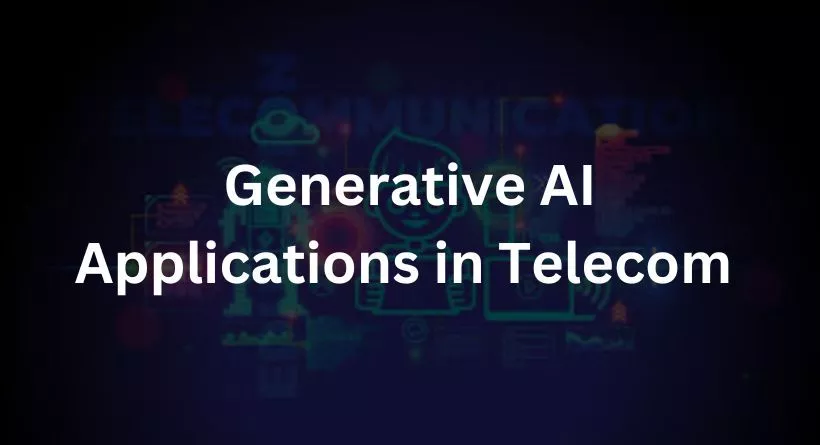
The telecommunications industry, a vital player in the digital revolution, is continually striving to meet the ever-evolving demands of a world that’s rapidly changing. In this article, we’ll delve into the groundbreaking potential of Generative AI applications in the telecom sector, exploring its impact on network management, customer experience, infrastructure planning, and revenue generation.
Embracing the Power of Generative AI

Generative AI, with its ability to create new data from existing information, is a game-changer for telecommunications. This powerful tool can transform the way the industry operates, paving the way for innovation and efficiency. Let’s explore its use cases.
You may also like reading: Generative AI Applications: In Energy & Utilities
1. Optimising Network Management and Performance with Generative AI
The management of telecommunications networks involves handling vast amounts of data, including traffic patterns, usage statistics, and performance metrics. Generative AI steps in to make sense of this data, identifying patterns and inefficiencies, which empower telecom companies to make data-driven decisions.
AI-driven algorithms dynamically allocate bandwidth based on real-time demand, ensuring optimal network performance and minimizing the risk of congestion or service disruptions. This leads to a seamless and uninterrupted user experience.
2. Enhancing Customer Experience with AI-Generated Insights
In today’s competitive telecom landscape, customer experience is paramount. Generative AI provides a unique advantage by generating insights into individual preferences, usage patterns, and service needs.
These insights enable telecom companies to offer personalized recommendations for services, plans, and promotions. This personalization creates a more relevant and engaging experience for users, fostering loyalty and satisfaction.
3. Intelligent Infrastructure Planning and Deployment
Telecom infrastructure, such as cell towers and data centers, requires careful planning and deployment. Generative AI comes to the rescue by analyzing data, including geographic and demographic information, to determine the most cost-effective locations for infrastructure.
Moreover, this technology can simulate different network configurations, helping telecom companies optimize their infrastructure designs. The result is not only cost savings but also improved network performance and reliability.
4. Streamlining Operations and Maintenance with AI-Driven Automation
Generative AI has the potential to streamline telecom network operations and maintenance. By automating routine tasks like network monitoring and fault detection, human resources are freed up for more strategic activities.
Additionally, AI helps predict and prevent equipment failures, minimizing downtime and ensuring peak network performance. The result is cost reduction, enhanced reliability, and a competitive edge.
5. Boosting Revenue Generation with AI-Driven Personalization and Analytics
The telecommunications market is highly competitive, and revenue generation is a constant goal. Generative AI enables companies to utilize AI-generated insights for more targeted marketing campaigns, identify revenue opportunities, and optimize pricing strategies.
This technology creates personalized offers and promotions, leading to higher conversion rates and customer loyalty. Analytics further helps identify untapped market segments and refine product and service offerings.
6. Harnessing AI-Powered Chatbots and Virtual Assistants for Customer Support
The role of AI in customer support is growing, with chatbots and virtual assistants taking center stage. These AI-driven solutions understand and respond to customer queries more effectively, providing accurate information and personalized recommendations.
This not only improves customer satisfaction but also reduces response times and support costs. Moreover, they collect valuable feedback and insights to refine products and services continually.
Embracing AI-Driven Innovation

In a rapidly evolving industry, embracing AI-driven innovation is crucial for telecom companies. This journey entails not only adopting generative AI technologies but also fostering a culture of innovation and data-driven decision-making within organizations.
By investing in AI-driven solutions and developing the necessary infrastructure, talent, and processes, telecom companies can fully leverage generative AI to drive transformative change. This positions them to adapt and thrive in a dynamic market, delivering enhanced connectivity, service quality, and customer experience.
Conclusion
Generative AI is a beacon of hope for the telecommunications industry, offering a pathway to innovation and efficiency. By harnessing the power of AI, telecom companies can enhance network performance, improve customer experiences, optimize infrastructure, streamline operations, boost revenues, and provide top-notch customer support. Embracing AI-driven innovation is the key to staying competitive in a fast-changing landscape.
FAQs
Q1: What is Generative AI, and how does it benefit the telecom industry?
Generative AI creates new data from existing information and benefits telecom by optimizing network performance, enhancing customer experience, and more.
Q2: How does Generative AI streamline telecom operations?
It automates routine tasks, reduces equipment failures, and cuts operational costs.
Q3: Can Generative AI help telecom companies boost revenue?
Yes, it provides insights for targeted marketing, personalized offers, and optimized pricing strategies.
Q4: What role do AI-powered chatbots play in customer support for telecom?
Chatbots provide accurate information, personalized recommendations, and reduce support costs.
Q5: How can telecom companies embrace AI-driven innovation?
By adopting AI technologies, fostering a culture of innovation, and investing in necessary infrastructure and talent.





